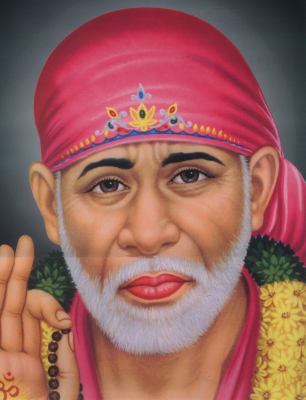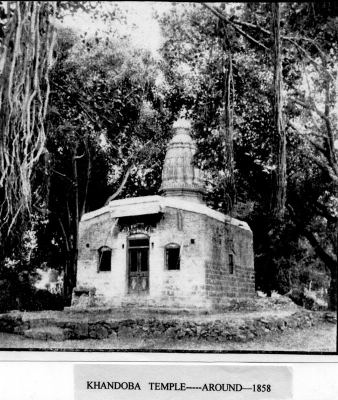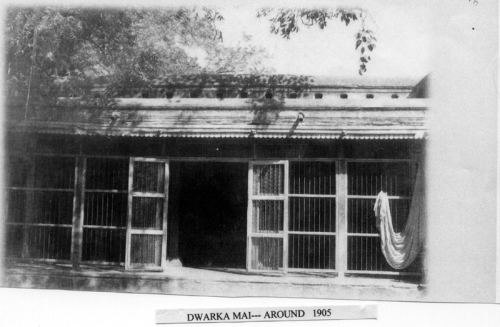
You look to Me, I look to you!
Little is known of the early years of Sai Baba of Shirdi. Even his name is unknown as Sai Baba is not an appellation in the usual sense. Sai is a term of Persian origin, usually attributed to Muslim ascetics, meaning holy one or saint. Baba, on the other hand, is a Hindi term attributed to respected seniors and holy men, and literally means “father”. So the etymology of Sai Baba means “holy father”, “saintly father”.
The Sri Sai Satcharitra refers to the occasion in which this “name” was supposedly attached to him. Mhalsapati, the pujari of the small Khandoba temple situated on the outskirts of the village, seeing the young man come to Shirdi with a wedding party, addressed him with the words, Ya Sai, meaning, Welcome, Saint. Following Mhalsapati’s example, others also addressed him so, to the extent that he generally became known as Sai. The term Baba was probably added later on as he grew older.

To the question, “Baba, who are you? From where did you come?” he replied: “I am the Attributeless, Absolute, Nirguna. I have no name, no residence”. He would also say the following: “I am Parvardigar (God). I live at Shirdi and everywhere. My age is lakhs of years. My business is to give blessings. All things are mine. I give everything to everyone. I am in Gangapur, Pandharpur, and in all places. I am in every bit of the globe. All the universe is in Me”.
From a dualistic point of view, he would say: “I got embroiled by karma, and came in a body. So I got a name and an abode. The dehi (body), that is, the embodied, is my name; and the world is my abode. Brahman is my father and Maya is my mother. As they are interlocked, I got this body. The world is evanescent, mutable.”
Sai Baba, from his very first appearance and throughout his life was commonly identified as a Muslim. The name Sai contributes largely to this.The main reasons for Sai’s identification as a Muslim ascetic – at least in the beginning – were two: his dress style and the words he uttered not in Marathi or Hindi, but were Persian or Arabic. The few photographs and hagiography tell us that Sai used to wear a long white robe, called kafni (or kaphan), and a white cloth around his head in the style of Muslim ascetics. Moreover, the term Sai Baba used for referring to himself was invariably faqir. This word, which literally means “a poor man” is commonly applied to Muslim mendicants who wander about subsisting on alms. Such fakirs and ecstatics of the dervish variety were found all over India. As faqir’s stem from heterodox Sufi brotherhoods, the inference that Sai Baba was Muslim readily gained currency.

Mhalsapathi – perhaps Sai Baba’s closest devotee in the early days – stated that Sai Baba had told him that he was a Brahmin from the village of Pathri, who had been entrusted to a fakir in his infancy. At the time of his demise (called samadhi in India), Baba supposedly said, “My fakir’s wife left me with Venkusa. I stayed with him 12 years, and left. Venkasa had spent much of his time in pilgrimages and performance of sacred rituals. He was rich and liberal and encouraged righteousness, piety and study. Unlike the majority of desh-mukhs and zamindars of the period who were known for cruelty and lack of moral values, Venkusa is pictured as saintly and very much in pursuit of his ishtadevata, his indwelling divinity. Young Sai is also reported to have said:
“For 12 years I waited on my Guru, who is peerless and loving. How can I describe his love for me? When he was in meditation I sat and gazed at him. We were both filled with bliss. I cared not to turn my eye upon anything else. Night and day, I poured on his face with an ardour of love that banished hunger and thirst.
The Guru’s absence, even for a second, made me restless. I meditated on nothing but the Guru, and had no goal, no object, other than the Guru. Unceasingly fixed upon him was my mind. Wonderful indeed, the art of my Guru. I wanted nothing but the Guru and he wanted nothing but this intense love from me.
Apparently inactive, he never neglected me, but always protected me by his glance. That Guru never blew any mantra into my ear. By his grace, I attained my present state”.
Arrival in Shirdi

Various sources agree that Sai Baba first arrived at Shirdi between 1835-1838, and stayed for some time, (some say for two months, some say for 5 years), perpetually seated in a asana (yogic) position under the Neem tree. All sources agree that Sai Baba remained seated at the Neem tree. Thereafter, Sai Baba left and wandered for many years. He met with Chand Patil in a village named Dhukpeda, and Patil’s son was being married; Sai Baba agreed to accompany the wedding party to Shirdi, where he arrived circa 1858, and was to remain there for another 60 years; Sai Baba never left Shirdi village.
There are reports that Sai Baba told his devotees that he had lived in Shirdi some 8000-10,000 years earlier. Also, there was one report that the pujari at the Khandoba temple was once possessed by the God who answered questions and told listeners to dig at a certain location. Upon digging, a large plate was found, and when it was lifted, a cave was discovered with lamps burning, and a holy shrine. Those who witnessed this covered the entrance up and worshipped there. It was the Vatan, the holy tomb (sometimes called samadhi) of Sai Baba’s Guru, one Venkusha. When Sai Baba returned to stay permanently at Shirdi, all historical sources agree his only possessions were his clothes, his chillum (pipe) and a small staff. He had no pack of clothes or possessions.
![]()

